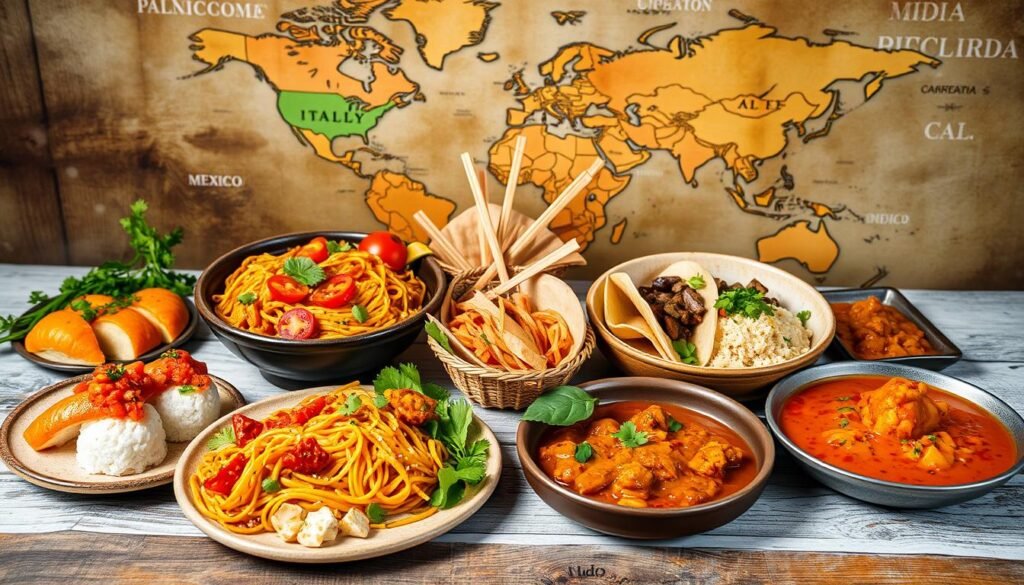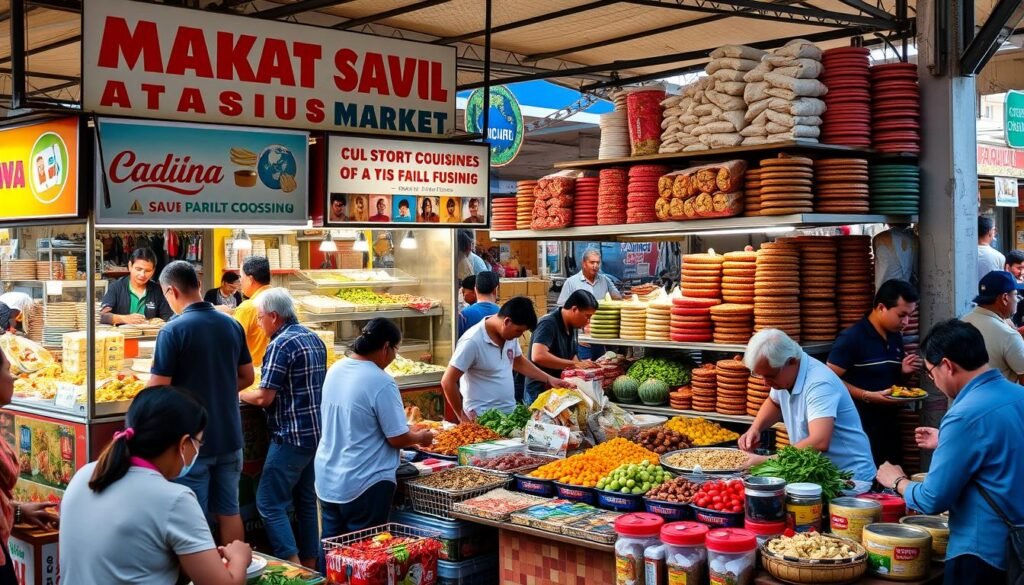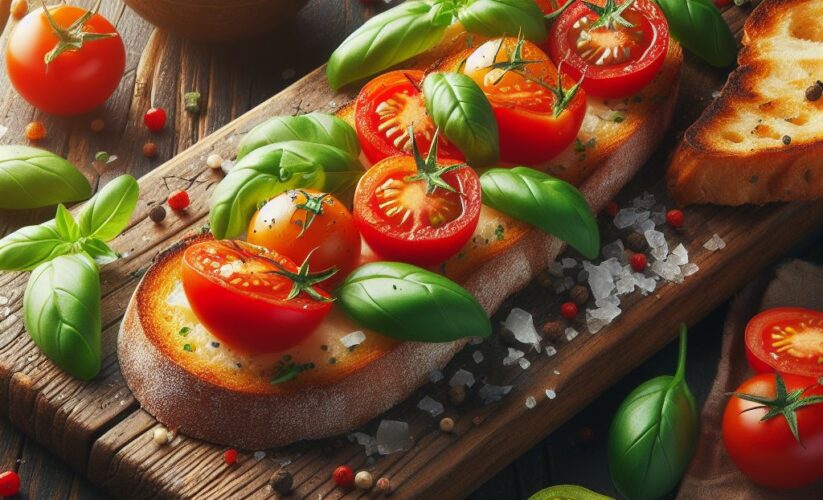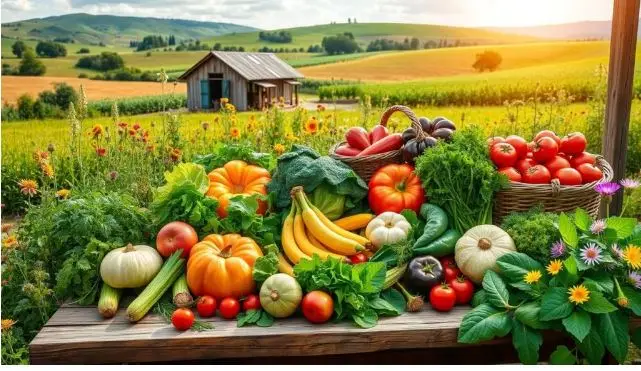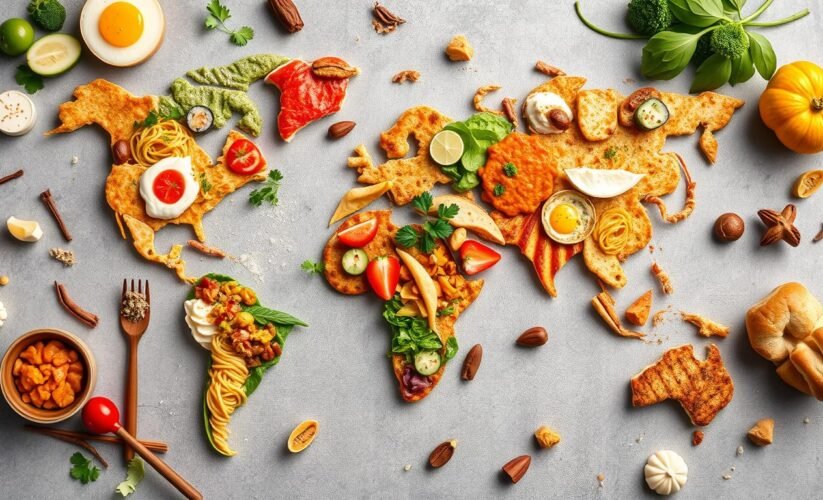
Exploring Global Cuisines: A Culinary Journey Around World
Have you ever thought about how a single dish can share a culture’s story? On this exciting journey, we’ll discover the rich world of international food. We’ll see the flavors, traditions, and histories behind them.
Exploring global cuisines shows us how food connects us. It’s a bridge between cultures. From India’s spices to the Mediterranean’s fresh ingredients, every bite tells a story. Let’s explore the world’s cuisine together.
Key Takeaways
- Food serves as a cultural expression reflecting history and geography.
- Each dish has a unique story that connects communities around the world.
- Local ingredients play a vital role in shaping regional cuisines.
- Exploring global cuisines enhances our appreciation for diversity.
- Food acts as a common language that unites us across cultures.
The Importance of Cultural Gastronomy
Cultural gastronomy is a rich mix of traditions, practices, and beliefs that shape our meals. It’s more than just food; it’s a way to share stories through every ingredient and dish. Food lets us express our identity and celebrate the diversity of flavors from different cultures.
Understanding Food as a Cultural Expression
Every dish has a story, showing the heart of a community. Family recipes and new culinary ideas both play a big role in cultural gastronomy. They help us connect with others and explore the world through food.
From India’s spicy curries to Italy’s savory dishes, each flavor is a window into a culture. It’s not just about taste; it’s about the values and traditions of a society.
How Cuisine Reflects History and Geography
Cuisine history tells stories of migration, trade, and cultural blending. The way food is made and what ingredients are used depends on the region’s geography and climate. For example, coastal areas often have seafood, while landlocked areas focus on agriculture.
Historical events, like colonization or trade routes, also shape local tastes. This shows how cooking practices change over time.
Looking at the links between food, history, and geography helps us see how dishes evolve. A simple meal can hold centuries of tradition, sacrifice, and adaptation. Cultural gastronomy encourages us to appreciate the deep impact of food on our identity and community.
Exploring Global Cuisines: A Culinary Journey Around the World
Exploring global cuisines takes us on a journey through different culinary regions. Each region offers unique flavors, ingredients, and cooking techniques. These reflect their cultural heritage. By trying diverse dishes, we gain a deeper appreciation for food as a cultural symbol.
Major Culinary Regions and Their Unique Flavors
Let’s look at some major culinary regions and their distinct tastes:
- Mediterranean: Known for fresh veggies, olive oil, and herbs. Try tabbouleh and moussaka for a taste.
- Asian: Offers a wide range of ingredients like rice, noodles, and spices. Enjoy curry and sushi for a flavor burst.
- African: Known for hearty dishes with grains, legumes, and spices. Don’t miss jollof rice and bunny chow.
- Latin American: A mix of indigenous and colonial tastes. Savor tacos and empanadas for a taste of this vibrant cuisine.
Traditional Recipes to Try at Home
Bring global cuisines into your kitchen with these traditional recipes:
| Recipe | Region | Main Ingredients |
|---|---|---|
| Spaghetti Aglio e Olio | Italian | Pasta, garlic, olive oil, parsley |
| Pad Thai | Thai | Rice noodles, eggs, shrimp, bean sprouts |
| Moroccan Tagine | African | Chicken, apricots, almonds, spices |
| Tacos al Pastor | Mexican | Pork, pineapple, onions, cilantro |
Ethnic Flavors and Their Influence on World Cuisine
Ethnic flavors have greatly shaped world cuisine. They bring unique ingredients and cooking methods. This has led to the creation of popular dishes loved by many.
These flavors show how cooking traditions change and affect our dining experiences.
Popular Ethnic Dishes That Have Made Their Mark
Many ethnic dishes have become favorites worldwide. Here are a few iconic examples:
- Sushi: This traditional Japanese dish combines vinegared rice with various ingredients, often including seafood, vegetables, and even tropical fruits.
- Tacos: Originating from Mexico, these flavorful treats feature a soft or hard shell filled with diverse ingredients like seasoned meat, beans, and fresh toppings.
- Curry: With roots in South Asian cuisine, curry offers a rich blend of spices and ingredients, leading to numerous regional variations recognized globally.
Fusion Cuisine: Blending Traditions for New Tastes
Fusion cuisine is all about mixing different cooking traditions. It lets chefs try new things and create exciting dishes. This trend brings together ethnic flavors and appeals to many tastes. Examples include:
- Korean Tacos: Integrating Korean BBQ ingredients into traditional Mexican tacos, this dish showcases a delightful mix of textures and flavors.
- Sushi Burritos: This fusion combines the freshness of sushi with the convenience of a burrito, making it a popular grab-and-go option.
- Italian-Thai Pasta: A clever twist that merges Italian pasta with Thai spice blends, producing a unique dining experience.
Food Tourism: Traveling the World Through Cuisine
Food tourism lets travelers dive into local cultures through food. It’s a special way to experience places and enjoy new tastes. Exploring places known for their food can be truly memorable.
Top Destinations for Food Lovers
Many places around the world are famous for their food. Here are a few must-visit spots for food lovers:
- Italy: Known for its wide range of dishes, from pizza in Naples to risotto in Milan.
- Thailand: Famous for its bold flavors, with street foods like pad thai and som tam.
- Mexico: Known for its vibrant tastes and fresh ingredients, with dishes like tacos and mole.
Best Food Festivals Around the Globe
Food festivals are great for food lovers to celebrate local tastes. They offer a chance to try many dishes and meet chefs and local artisans. Here are some famous festivals:
| Festival Name | Location | Highlights |
|---|---|---|
| La Tomatina | Spain | A tomato-throwing festival with a twist. |
| Melbourne Food and Wine Festival | Australia | Features the best local food and wine pairings. |
| Oktoberfest | Germany | Known for its beer and traditional German sausages. |
Culinary Diversity: A Celebration of Ingredients
Culinary diversity is a rich mix of food cultures from all over the world. It’s shaped by local ingredients and unique dishes from different regions. The variety of flavors and cooking styles comes from the unique environments and climates of each place.
Understanding how local ingredients influence regional dishes deepens our appreciation of global cuisines. It shows how food connects us to our surroundings and cultures.
How Local Ingredients Shape Regional Dishes
Local ingredients are the foundation of regional dishes. They let communities create meals that show their geographical and cultural roots. Each region has its own special produce, herbs, and proteins, often passed down through generations.
For example, fresh tomatoes in Italy are key to making classic sauces. In India, spices create bold curries.
- Examples of local ingredients influencing regional cuisine:
- Rice in Southeast Asia enhances the flavor of traditional meals.
- Chili peppers in Mexico add heat and character to salsas and dishes.
- Fish in coastal areas provides freshness found in dishes like ceviche.
The Role of Seasonal Eating in Culinary Traditions
Seasonal eating is vital in culinary traditions worldwide. Eating what’s in season brings out the best flavors and supports local farmers. It connects our culinary experiences to the production of food, encouraging a more mindful way of eating.
| Season | Common Local Ingredients | Popular Dishes |
|---|---|---|
| Spring | Asparagus, peas, strawberries | Spring vegetable risotto, strawberry shortcake |
| Summer | Tomatoes, zucchini, corn | Caprese salad, grilled corn on the cob |
| Autumn | Pumpkin, apples, root vegetables | Pumpkin soup, apple pie |
| Winter | Brussels sprouts, citrus, winter squash | Brussels sprouts salad, roasted citrus squash |
Global Food Trends Reshaping Culinary Practices
Global food trends have changed a lot lately. People now want to eat healthy, not just for taste but for wellness too. Plant-based cooking is becoming more popular, changing how we cook everywhere. This shows a big move towards eating better and caring for the planet.
Healthy Eating: A Shift in Global Preferences
Healthy eating is big in many places. Superfoods, organic stuff, and whole grains are common in kitchens. Folks want meals full of good stuff like vitamins and minerals. It’s not just a trend; it’s a serious effort to get healthier.
- Increased availability of fresh produce in grocery stores
- Growing interest in meal prep for health-conscious eating
- Rise in specialized diets, such as Mediterranean and ketogenic
The Rise of Plant-Based and Sustainable Cooking
Plant-based cooking is becoming a big deal. Chefs and home cooks are using veggies, beans, and grains more. It’s good for health and the planet. As more people try vegetarian and vegan, we see new, tasty ways to use plants.
| Plant-Based Ingredients | Health Benefits | Sustainable Practices |
|---|---|---|
| Quinoa | High in protein and fiber | Low water usage compared to rice |
| Chickpeas | Rich in vitamins and minerals | Beneficial for soil health through nitrogen fixation |
| Leafy Greens | Packed with antioxidants and nutrients | Can be grown locally, reducing carbon footprint |
The Art of Traditional Recipes Across Cultures
Traditional recipes are more than just food. They carry stories, traditions, and a sense of belonging. These dishes nourish us and connect us to our heritage. Preserving these recipes is key to sharing our culinary legacy with future generations.
Preserving Heritage Recipes for Future Generations
Heritage cooking is crucial for passing down traditions. Families have special recipes that tell their stories. Around the world, groups work to preserve these recipes.
They hold community cook-offs, workshops, and share on social media. This keeps our culinary history alive.
Cookbooks and Resources for Exploring World Cuisine
Cookbooks are treasure troves of traditional recipes. They let us explore different cultures and learn their histories. Here are some top cookbooks for heritage cooking:
| Cookbook Title | Author | Focus Area |
|---|---|---|
| “Salt, Fat, Acid, Heat” | Samin Nosrat | Culinary fundamentals with global recipes |
| “The Joy of Cooking” | Ila Sokoloff | Classic American and international cuisine |
| “Jerusalem: A Cookbook” | Yotam Ottolenghi and Sami Tamimi | Middle Eastern dishes and traditions |
| “Mexican Everyday” | Rick Bayless | Authentic Mexican cooking for the home |
These cookbooks offer more than recipes. They give us a glimpse into different cultures and traditions. By exploring these recipes, we enrich our cooking and connect with diverse histories.
Fusion Cuisine: The Best of Both Worlds
Fusion cuisine is a mix of different cooking traditions, creating new flavors and experiences. This approach has led to many popular fusion dishes that excite our taste buds. Food lovers can also explore their own creativity by creating recipes that match their tastes.
Popular Fusion Dishes to Experience
Some popular fusion dishes are true masterpieces of flavor mixing. Here are a few:
- Kimchi Quesadillas: A spicy Korean twist on the classic Mexican quesadilla, blending fermented cabbage with melted cheese.
- Pho Tacos: This dish combines Vietnamese pho ingredients with the classic taco, bringing fresh herbs and flavors together.
- Sushi Burrito: A handheld sushi roll that blends elements of Japanese and Mexican cuisine, offering a portable meal bursting with flavor.
Creating Your Own Fusion Cuisine Recipes
Be your own chef by creating recipes that mix ingredients in a new way. Here are some tips for your culinary creativity:
- Start with a base dish, such as pizza or salad, and think of unexpected toppings or dressings that can enhance the original.
- Experiment with different spices and herbs from diverse cultures to add depth and excitement.
- Consider technique combinations, like using a stir-fry method for Italian ingredients.
With these tips, diving into fusion cuisine is a fun journey. Anyone can make amazing meals.
Join the Culinary Journey: Share Your Experiences
Every food journey is special, and sharing your culinary adventures can connect you with different cultures. Maybe you’ve tried a lively street food in Bangkok, mastered an Italian pasta dish, or tried new flavors at home. Your stories add to a rich global tapestry.
Sharing your food experiences with others is rewarding. You can do this through blogs, social media, or local food groups. This way, you create a space for everyone to share and learn. You get to hear about new cooking methods, ingredients, and cultural traditions.
As you try new foods, remember that every meal is a chance to connect. Share your food journey with others. Together, we can build a community that loves food. Each dish has a story, and by sharing yours, you help us understand our world’s diverse food scene.
